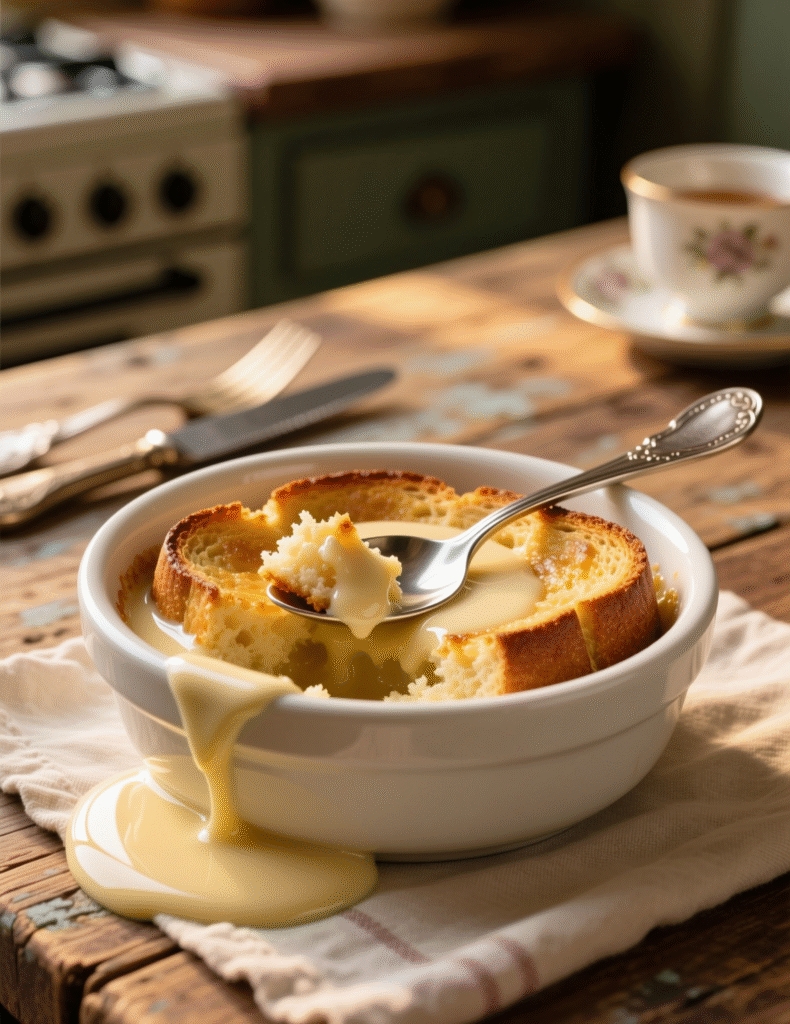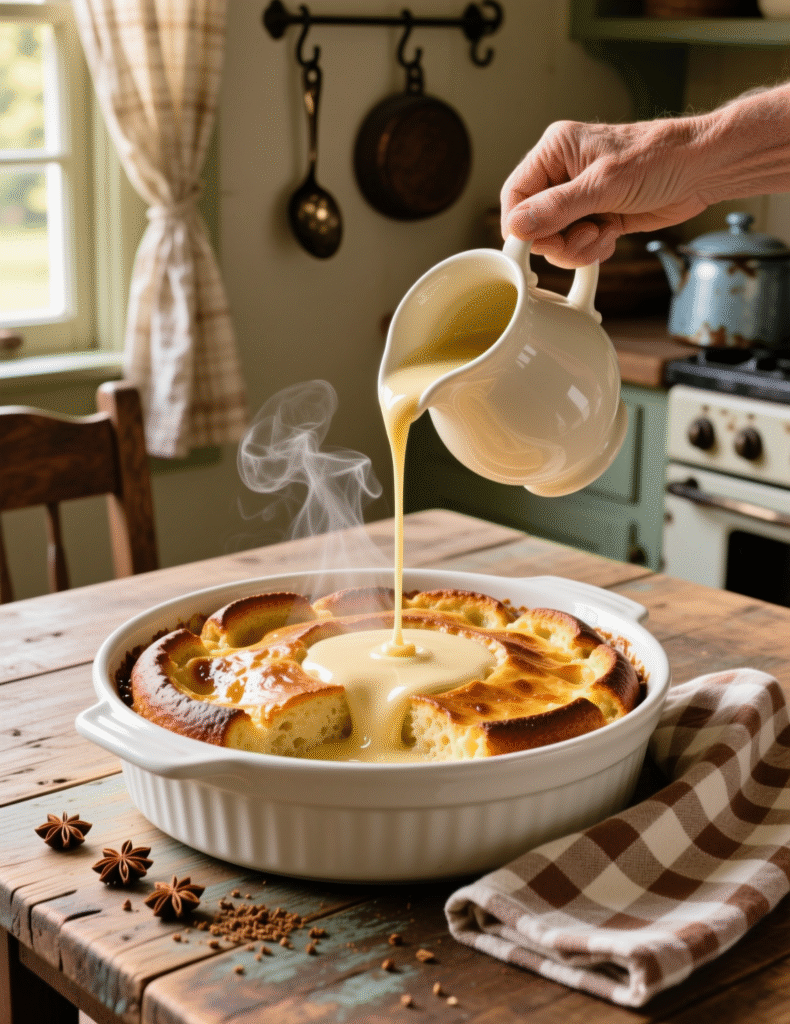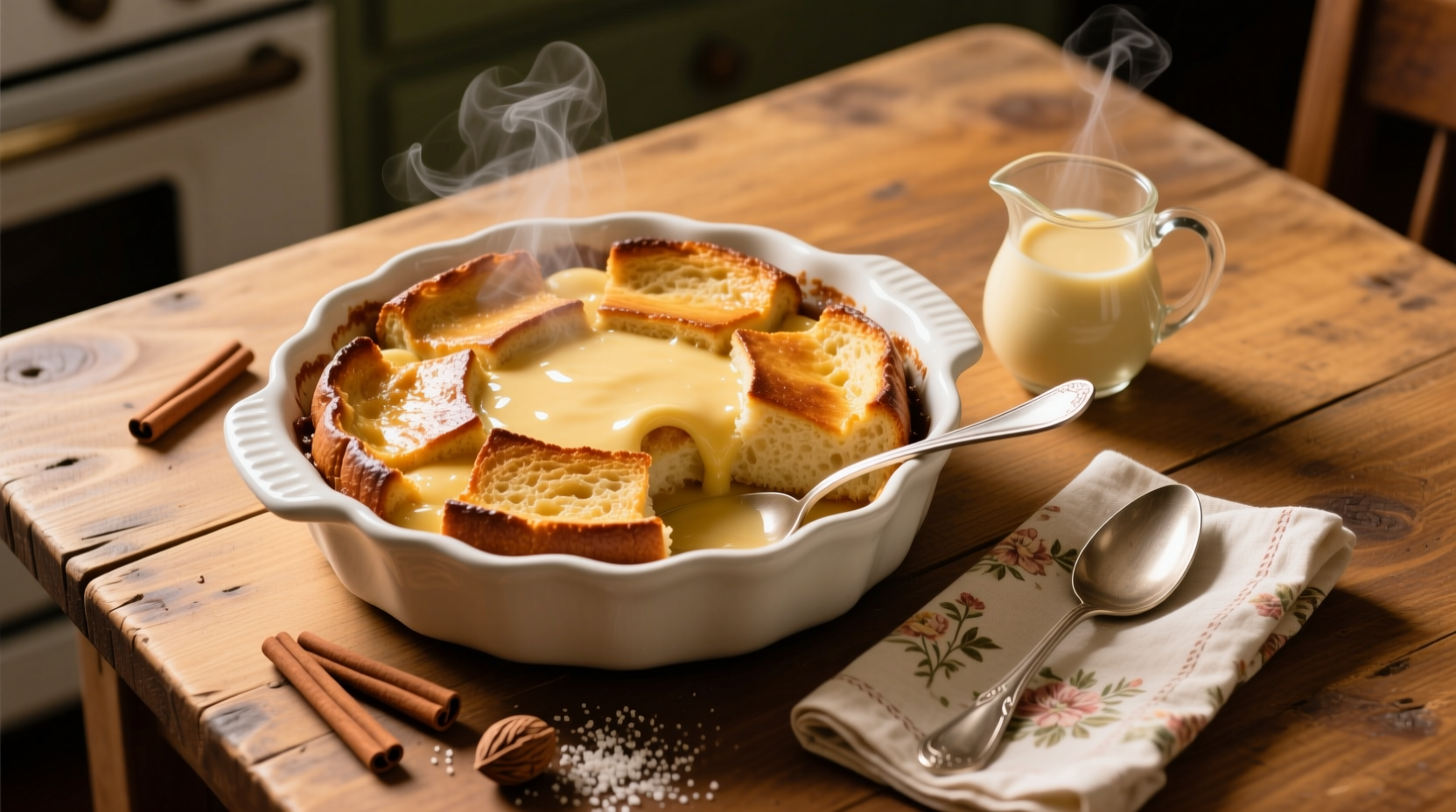You can taste memory when you bite into Grandma’s old-fashioned bread pudding. The custard, the bread, the soft warmth of vanilla—none of it feels fancy, but somehow it always feels perfect. This isn’t just dessert. It’s history passed on with milk and eggs, baked golden, then ladled with a sauce that clings like comfort. Today, we’ll walk through the full recipe, but also dig deeper into why this dish matters, how professionals elevate it, and the science that quietly works in every spoonful.
Why Bread Pudding Still Matters
Bread pudding began as survival food. In medieval Europe, cooks hated waste, so stale bread became the base for desserts. Instead of tossing hardened loaves, they soaked them in milk and eggs, turning scraps into something new. That tradition followed immigrants to America, where it became a staple in Southern kitchens.
What’s remarkable is how resilient the recipe has stayed. Even now, pastry chefs reinvent it with brioche, croissants, or panettone. Yet the core never shifts—bread, custard, and heat. That backbone makes it both timeless and endlessly adaptable.
Ingredients That Tell a Story
The bread is not just bread here. It’s texture and structure. Stale French bread works best because the dry crumb pulls in custard like a sponge. If you use fresh bread, it goes mushy too quick. Some chefs dry their bread cubes in the oven for 15 minutes to mimic staling—works like a charm.
Eggs are the silent engineers. Without them, you don’t get custard; you get soggy bread soup. Each egg yolk binds proteins, which firm up gently in the oven’s heat. Too many eggs, though, and your pudding turns rubbery. That’s why balance matters.
Vanilla sauce plays a finishing role, but don’t treat it like an afterthought. The sauce adds contrast—smooth liquid against dense pudding. Real vanilla beans bring tiny specks of flavor, but high-quality extract is fine for home kitchens. The fat from butter in the sauce gives your palate richness, almost like silk running over velvet.

Grandma’s Recipe: Bread Pudding with Vanilla Sauce (8 Servings)
Ingredients for the pudding:
- 6 cups day-old French bread, cubed
- 4 cups whole milk
- 4 large eggs
- 1 cup granulated sugar
- 1 tsp cinnamon
- 1 tsp vanilla extract
- ½ cup raisins (optional but traditional)
- 2 tbsp unsalted butter, melted
For the vanilla sauce:
- 1 cup whole milk
- 1 cup heavy cream
- ½ cup sugar
- 2 egg yolks
- 1 tsp vanilla extract
- 2 tbsp unsalted butter
Method:
- Preheat oven to 350°F (175°C). Butter a 9×13 baking dish.
- Place bread cubes in dish. Scatter raisins over top if using.
- In a large bowl, whisk milk, eggs, sugar, cinnamon, and vanilla. Pour over bread. Let sit 10 minutes so bread soaks custard.
- Drizzle melted butter over top. Bake 45–50 minutes until golden and center is set but soft.
- For sauce, heat milk and cream gently until warm. In another bowl, whisk sugar and yolks. Temper with warm milk, then return to pot. Stir over low heat until thick enough to coat spoon. Remove from heat. Add butter and vanilla.
- Serve pudding warm, with sauce spooned generously over each slice.
The Science Behind the Custard
Custards are fragile systems. They rely on proteins in eggs coagulating slowly, at precise temperatures. If you bake too hot, eggs scramble. That’s why most bread pudding recipes recommend 325–350°F. At this range, the proteins set gently, forming a delicate network that holds milk and sugar in place.
Professional kitchens sometimes bake pudding in a water bath. This moderates heat, preventing curdling. At home, though, most folks skip it and accept a firmer texture. Neither is wrong—it depends if you want restaurant-level finesse or rustic charm.
Bread Pudding Across Cultures
While we call this “Grandma’s recipe,” every culture seems to claim bread pudding as its own. In England, it’s heavy with dried fruits and nutmeg. In Louisiana, bourbon sauce often replaces vanilla sauce, giving it Southern swagger. In Latin America, there’s “budín,” often flavored with dulce de leche or tropical fruits.
This adaptability explains why it never dies out. Food trends may come and go, but bread pudding survives because it bends to whatever pantry you have. That’s why chefs return to it—it’s a canvas more than a recipe.

Why Vanilla Sauce Matters
A lot of folks serve bread pudding plain, and that’s fine. But vanilla sauce lifts it from good to extraordinary. The sauce’s creaminess balances the chew of baked bread. Vanilla compounds also pair naturally with egg proteins, amplifying the custard’s richness.
In blind tastings, desserts with a sauce often score higher in texture and satisfaction. One 2018 food science study found that contrasting temperatures and textures create stronger memory markers in diners. That’s why hot pudding with cool sauce—or warm sauce over warm pudding—sticks in your mind long after the plate is empty.
Professional Tips for Perfect Results
- Cube evenly: irregular bread cubes bake unevenly. Uniform size gives you consistent soak and bake.
- Don’t skimp on soak time: bread needs at least 10 minutes to absorb custard fully. Some chefs leave it overnight in the fridge.
- Balance sugar: too much, and the custard weeps liquid. Sugar pulls water from proteins, so keep it moderate.
- Experiment with breads: brioche gives sweetness, sourdough adds tang, croissants make it buttery-rich. Each choice tells a different story.
- Reheat with steam: microwave dries it out. Instead, cover with foil and warm in oven with a small dish of water placed inside.
Common Misconceptions
Some people think bread pudding is just leftover bread thrown together. That’s half true, but misses the precision behind it. Too much liquid, and you drown the bread. Too little, and it stays dry in the middle.
Others believe it has to be heavy. Not at all. With lighter breads and careful ratios, you can create airy versions that feel closer to soufflé than stodgy pudding.
Nutrition and Modern Tweaks
Let’s not pretend bread pudding is light eating—it’s dessert. But nutritionists highlight ways to trim without losing soul. Whole-grain breads add fiber. Swapping half the cream for low-fat milk cuts fat grams by a third. Using honey instead of sugar lowers glycemic load slightly.
Chefs also explore plant-based versions. Flaxseed can replace eggs, and coconut milk works instead of dairy. Results differ, but the spirit stays intact. That shows bread pudding’s resilience even in vegan or health-conscious kitchens.
Why We Keep Coming Back
Bread pudding hits emotions before it hits taste buds. For many, it’s the smell of Sunday dinners or the quiet hum of a grandmother’s kitchen. But even in fine dining, it offers nostalgia alongside creativity. You can dress it with caramel, spices, or spirits, but the core always feels familiar.
In culinary competitions, judges often praise bread pudding for its “comfort-to-cost” ratio. Cheap ingredients, high emotional return—that’s power in a dish.
Final Thoughts
Grandma’s old-fashioned bread pudding with vanilla sauce is more than a recipe. It’s a ritual of using what you have, of turning simple things into unforgettable ones. It’s bread, milk, eggs, sugar, and time—all transformed by heat and memory.
If you’re cooking for guests, don’t just follow the recipe. Think about your bread choice, your sauce texture, your oven’s temperament. Small shifts make big differences. And if you’re eating alone, all the better—there’s joy in a warm bowl of pudding without anyone watching.
The real lesson is this: don’t underestimate simple food. Done well, it lasts centuries, carries cultures, and reminds us of kitchens that came before. Bread pudding, especially with vanilla sauce dripping down its sides, proves that elegance doesn’t always wear a suit. Sometimes it just shows up in a casserole dish.
FAQs
What is the best bread to use for bread pudding?
Day-old French bread or brioche works best because it absorbs custard without turning mushy.
Can I make bread pudding ahead of time?
Yes, assemble it the night before and bake the next day for deeper flavor.
How do I know when bread pudding is done?
It’s ready when the top is golden and a knife in the center comes out clean but moist.
Can I freeze bread pudding?
Yes, freeze in portions and reheat gently in the oven for best texture.
Do I have to add raisins?
No, they’re optional—swap with chocolate chips, nuts, or dried cranberries.
Why is my bread pudding watery?
Too much liquid or underbaking usually causes watery pudding.
Can I make vanilla sauce without cream?
Yes, use all milk instead of cream, though the sauce will be lighter.
What’s the difference between bread pudding and French toast casserole?
Bread pudding is more custardy, while French toast casserole is firmer and eggier.
Can I make bread pudding vegan?
Yes, replace eggs with flaxseed and milk with coconut or almond milk.
How long does bread pudding last in the fridge?
It keeps well for 3–4 days when stored in an airtight container.

Mariana is a passionate home cook who creates delicious, easy-to-follow recipes for busy people. From energizing breakfasts to satisfying dinners and indulgent desserts, her dishes are designed to fuel both your body and hustle.
When she’s not in the kitchen, she’s exploring new flavors and dreaming up her next recipe to share with the Foodie Hustle community.

